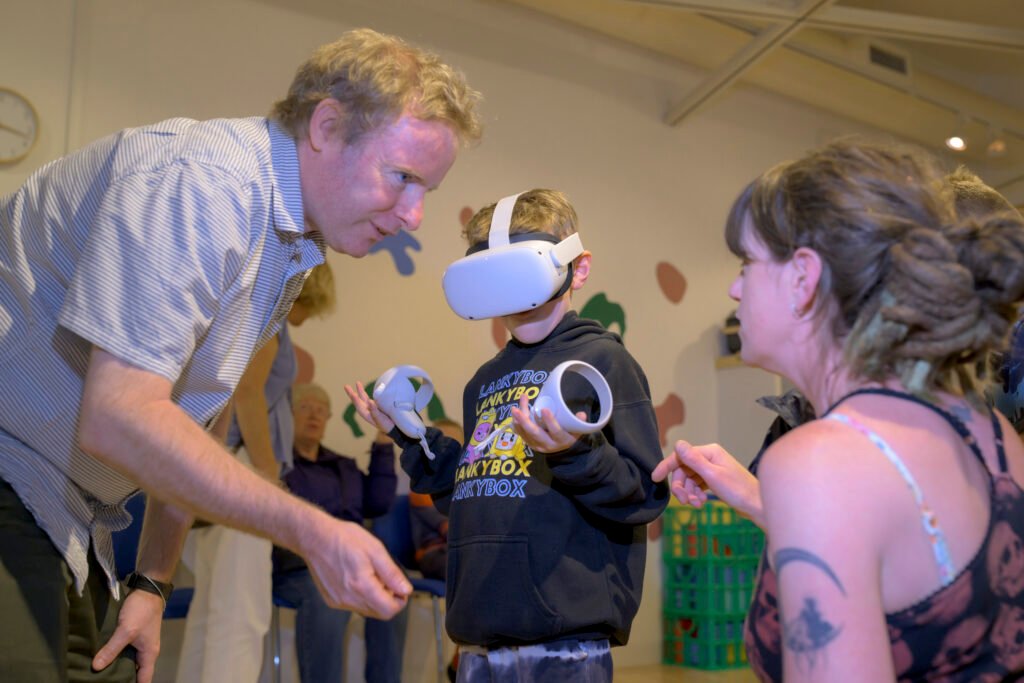
The aim of this project was to explore, test and identify the creative and technical possibilities of utilising immersive media technologies in local authority run combined arts and heritage venue Rugby Art Gallery and Museum (RAGM). Focussed on the themes of digital storytelling and technology for social good, we developed a feasibility study which will act as a platform to develop creative solutions which encourage visitor/user interaction and exploration of RAGM’s exhibits and education programme.
Supported by an NCACE Micro-Commission, our collaborative relationship enabled us to share specialist knowledge on immersive technologies, creative innovation, interactive media, and education in these fields, as well as learning and engagement in a Museum and Art Gallery setting. Project leads included Robin Kay, Lecturer in Media and Communication with a New Media specialism at Birmingham City University (BCU) and Academic Coordinator for BCU’s STEAMhouse, Dr Vanessa Jackson associate professor in the Institute of Media and English at BCU, Charmaine Stint, Programme Manager for BCU’s institute for Creative Innovation, and Phoebe Hilton Senior Learning and Engagement Officer for RAGM.
The project took a place-based approach, taking inspiration from the RAGM’s Summer Exhibition ‘The Art of Making Comics and Films’, which explored sequential art and storytelling from concept to comic strip and from sketchbook to the silver screen, tracking the creative process from ideation to creation. BCU and STEAMhouse joined RAGM for the launch of the exhibition, testing the use of VR and AR at the event. Both AR experiences used were Target image initialised, one consisted of an animated 3D model and the other was a walk-through video of a 3D environment hosted by Meta Spark. At this event we completed a UX study of participants, which supplemented the feasibility study of the technologies tested for wider uses in the building.
As part of the testing process, we also explored 360 video, producing a test of the Archaeology Gallery at RAGM, and have begun to 3D scan objects to explore how we can support visitors in getting closer to the artefacts we have on show in this space.
The feasibility study focussed on five key areas of analysis:
- An inspection of the suitability of potential space and support infrastructure
- Identification of user/visitor needs (will require a UX study with involvement from potential visitors)
- Identification of potential suitable creative solutions for collections and exhibits
- Identification of potential technological resources required for delivery of the next phase
- Identification of staffing needs for delivery of the next phase
Our overarching finding, with all identified recommendations in mind, was that the design and implementation of immersive experiences in the Art Gallery and Museum must allow for audience and user agency in exploring and interacting with the museum and gallery spaces. This is due to staffing, space, infrastructure, technological resources, and user experience needed to deliver experiences which rely on supervised equipment or the user to have existing skills or knowledge.
We found that experiences which rely on apparatus, for example, headsets, would put excessive strain on staffing requirements to effectively supervise and facilitate their use. Furthermore, the use of such apparatus could potentially negatively impact the visitor’s experience. Factors contributing to this disappointment include young visitors not being able to engage with the experience due to the ergonomic design of the headset and their lack of understanding of technological instructions, and lack of access due to queues. The numbers interested in participating in activities of this kind also impacted the safe operational delivery of the VR experience. This insight supports the observation on the need for staffing, with a minimum requirement of personnel, to supervise the activity and space. This has led us to determine a need to prioritise exploration of the use of AR in our spaces for future activity.
The production or AR or other interactive media the identification of potential technological resources to design, create, deliver, and host an immersive experience is broad. In terms of hardware, this may include an appropriate 360 camera and microphone for the production of 360 videos with ambisonic sound, and tablets to support roaming access to AR experiences hosted on specific apps, such as Vuforia or 8thwallstudio. We may also require software such as Polycam for 3D scanning, Unity or Unreal for gamifying experiences, Adobe Premier and Captivate for video editing and producing e-learning tools respectively, alongside alternatives such as Articulate 360, Matterport, and Kuula, as well as AR software including Adobe Aero, Lens studio, Meta Spark studio and more.
With this in mind, the scale and sophistication of future experiences is to be determined by partnership working and support and training for Art Gallery and Museum staff to continue develop their skills in using these programmes/technologies. Equally, projects will be considerate of the time required to develop and test applications for delivering an immersive experience, with bespoke experiences developed in future connecting to permanent exhibits rather than temporary visiting exhibits in the Gallery and Museum.
Based on the foundations built in this micro-commission project, we all share an appetite for the next steps. We have established positive relationships of collaborative working, with a fine balance of understanding and respect between partners. BCU have been generous in their advice on integrating new technologies into RAGM’s exhibition portfolio, and in sharing solutions to delivering outcomes that meet the aims and objectives of Rugby Art Gallery and Museum and Rugby Borough Council. Equally, RAGM are invested in supporting BCU in developing the research practice of their Academic base and facilitating new initiatives and ideas, including bringing BCU students into the collaboration to work on projects with real world application.
“I’m delighted with how the project has gone, and with the potential for future collaborations with RAGM.” Vanessa Jackson
“It has been such a wonderfully positive experience working with you all on this project. I am excited for what comes next!” Phoebe Hilton
Image credit: Rugby Art Gallery and Museum
